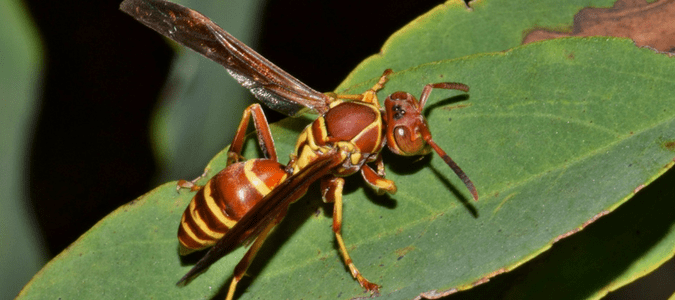
It’s a hot summer day and you walk outside your front door, greeted by a familiar buzzing sound; only, it’s not a bee. It’s another scary looking creature—a red paper wasp. You know it stings, and you know where there is one wasp, a nest isn’t too far away. But what brought it to your doorstep? How can you get rid of it? What if you notice an orange wasp, or a mahogany wasp—are they related? What about a red hornet? What does a red wasp nest look like? And most importantly, how can you keep these pests from coming back and making your home their own?
The first step in understanding how to deal with any type of unwanted pest is to learn more about it. Once you know how to identify red wasps and what attracts them, you’ll be better equipped to get rid of them—for good.
Do I Need To Be Worried About A Red Hornet?
Most of us don’t know the difference between a wasp and a hornet, so sometimes red wasps can be mistakenly referred to as “red hornets”. The only true hornet species that can be found in the United States is actually invasive: the European hornet, sometimes also referred to as the giant hornet. These yellow and brown insects can grow to be about an inch long are most often found in the eastern part of the country. What is commonly referred to as a baldfaced hornet, which is black with yellow or white bands, is actually a type of yellow jacket.
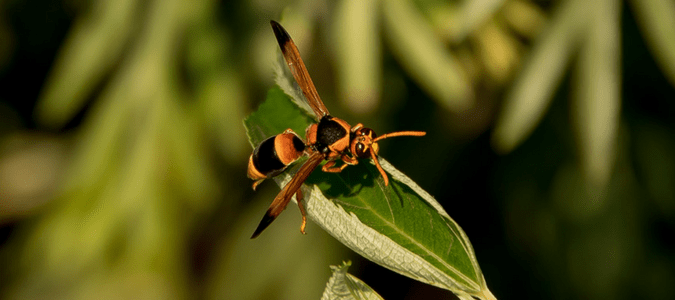
Are Orange Wasps Dangerous?
Assuming you live in the United States, chances are that if you see a wasp that is orangish in color, it’s actually a red wasp. There is a variety of orange wasps that you can find in Australia which are called potter wasps or mason wasps, which are closely related to the mud dauber. Potter wasps lay their eggs in large nests made of mud. These insects have orange wings with black towards the tips and a band of back around the abdomen.
Here in the United States, we also have potter wasps, but they are black in color. Whether these insects are found in the States or Down Under, they rarely attack humans and are not aggressive creatures by nature. As is the case with most animals which are threatened, there is the possibility that you could get stung during an encounter with one of these orange (or black) wasps, in which case you might experience a significant amount of pain which can be relieved with an ice pack. Assuming you stay a safe distance away, potter wasps (and paper wasps) are considered beneficial garden insects because they feed on caterpillars and some types of beetle larvae.
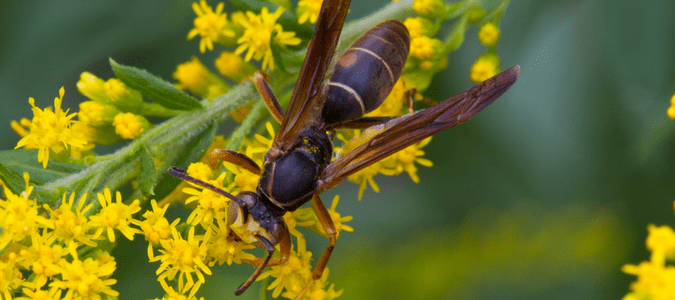
What About Mahogany Wasps?
Our first urge when we see what could be a stinging insect is to head in the other direction, so it’s no wonder that wasps are often only described by their color. Two types of paper wasps which are so similar that even experts have a hard time telling them apart are the Polistes fuscatus (Northern paper wasp) and Polistes metricus. Both insects sport a red-brown coloring and the latter has a more limited geographic distribution which extends from the southwestern-most areas in Ontario and Maine south down to Florida and west to include southern parts of Ohio, Nebraska, Kansas, Oklahoma and the eastern reaches of Texas. The Northern paper wasp is more common across all geographic regions in the United States.
Mahogany wasps are also welcomed by gardeners because they chew caterpillar larvae and then feed the resulting material to their young. Adult wasps prefer to dine on nectar from flowers. They also clean up after aphids, eating the “honeydew” waste product these garden pests excrete.
If you are wondering how dangerous mahogany wasps are, the answer will be the same for these other stinging insects. When threatened, mahogany wasps can and will sting. Thankfully, most people only experience temporary discomfort and do not require emergency medical attention.
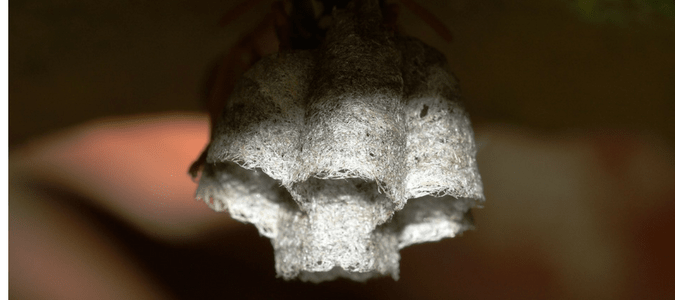
Red Wasp Nest Facts
Now that we’ve gotten the semantics out of the way, let’s talk about the insect you probably saw buzzing by your doorstep: the paper wasp. The scientific name for these creatures is Polistes carolina. These insects are found mostly in the eastern and south-central parts of the United States and are characterized by their reddish-brown color. Red wasps have slim-waisted bodies, black wings that fold back when at rest and can be anywhere from ¾ to one inch in length.
Red paper wasps are semi-social insects made up of colonies of workers, queens and males. Red wasps are often called paper wasps because of the paper-like nests they build during the early springtime, usually around the crevices or entryways of houses. The umbrella-shaped homes are made of a combination of finely chewed wood particles and the wasp’s saliva. You may also notice a nest in a bush, on a tree branch, around door or window frames, on attic rafters, on the ceiling of your porch and under and around railings and decks.
In the springtime, queens select a nesting site and begin to build their nests. Eggs are laid individually in each cell which faces downward. Once they hatch, grub-like larvae emerge that go through several stages of development before fully pupating. Sterile worker bees feed the young and protect the nest, since the cells of the nest remain open as the larvae pupates.
A fully mature nest can contain as many as 20 to 30 adult wasps during the summer months. Once fall approaches, the queen stops laying eggs and the colony begins to decline. Mated females seek protection in crevices to overwinter and build their own nests the following spring while the rest of the colony dies as the weather gets colder. The average lifecycle of a paper wasp is not even a year, lasting from the late-spring into the fall. Wasps start a new colony every year and rarely re-use that year’s nest.
Diet And Habitat
During the day, paper wasps are actively foraging for food. At night, these insects rest together with the colony. Since they have to create their nest out of wood fibers, paper wasps have chewing mouthparts they use to collect materials for the nest as well as to prey on insects, including caterpillars, flies and cicadas. Paper wasps will also seek out larvae from other insects to feed to their own larvae.
In addition to feeding on prey, red wasps also feed on plant nectar, which is why you’ll sometimes find them in your garden, especially if you have a bed of goldenrod flowers.
Paper wasps can take up residence around your home in a variety of places. They hang their nests from branches of trees, in shrubs, along eaves, on tops of windows and doorframes, underneath deck floors or even on railings around your deck. When it’s peak wasp season, be sure to inspect your outdoor spaces thoroughly to check for any paper wasps that may have built nests.
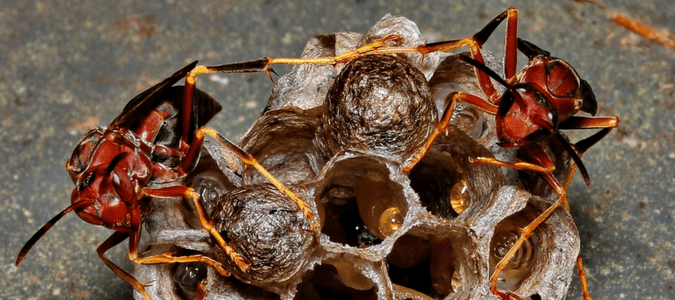
Beware Of Wasp Stings
Red wasps aren’t known to be aggressive, but they will sting if they feel threatened or if you threaten their nest. Since wasps are protecting the larvae from potential predators, you could be seen as a threat if you come too close to the nest.
Wasp stings are relatively common and are quite painful. Unlike other stinging insects, wasps can sting you multiple times. Red wasps pose the same risk of allergic reaction as other stinging insects, but other than that, you’ll feel pain and swelling localized to the area of the sting.
Prevention Tips
Red wasps build their paper-like nests around residential yards, which is why it’s important to inspect your property for signs of activity. If you do find a nest around your home, your best bet is to try to remove the nest at night, when the wasps are sleeping. To discourage red wasps from hanging around on your property, take the following steps:
- Trim shrubs and hedges around your yard regularly. Once you have checked to make sure there isn’t an existing nest, trimming back foliage will keep them from having a place to build.
- Treat your deck with an oil repellent to deter wasps from gathering the wooden fibers needed to build their nest.
- Use an insecticide for wasps and hornets. Be sure to follow the label instructions and spray at night when paper wasps are inactive.
- Clean up trash and spills outside and reduce excess moisture in your yard. If you are wondering what attracts wasps, the answer is food, water and shelter, so whatever you can do to deprive the wasps in your yard from getting these things will help reduce the wasp population in your yard.
- Keep lights off unless needed outside of doorways. Wasps are one of the types of bugs attracted to light, and we tend to have lights on outside of our front and back door at night. Keeping a light on outside at night is like putting out the welcome mat for wasps, so keep your lights low when possible to reduce the risk of wasps hanging out at your entryways.
ABC Can Help You Get Rid of Biting Insects
Dealing with red wasps can be scary. The thought of getting stung is enough to make most homeowners call in the professionals. The experts at ABC Home & Commercial Services will set up a time to inspect your home, assess your wasp problem and get rid of your existing colonies for good. With ABC’s pest control professionals, you won’t have to worry about getting stung when you are out, enjoying your outdoor spaces.
